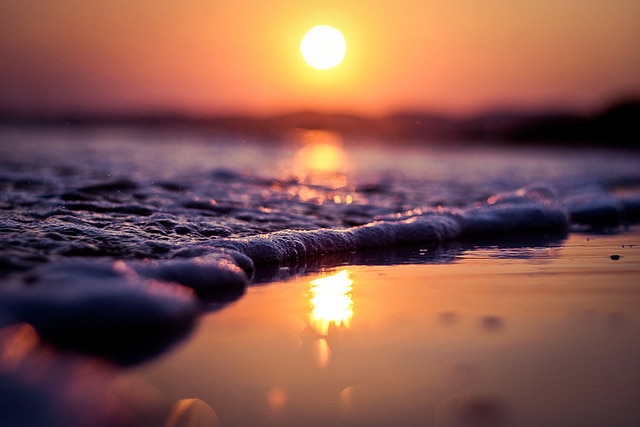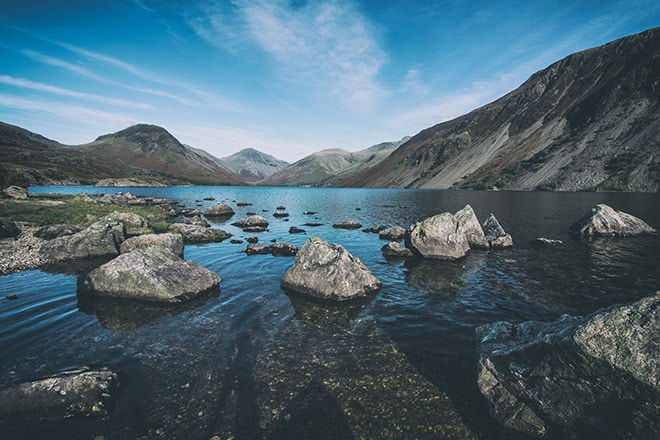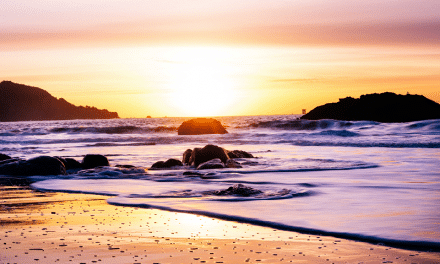A beautiful sunset. A scene bathed in spectacular light –sunsets are a photographer’s dream come true, presenting a chance for some truly dramatic images.
But while sunsets present excellent photo opportunities, capturing the tremendous beauty of a sunset can be difficult! It’s hard to convey the complex range of colors, light, and beauty of a sunset, into a simple two-dimensional image. And then there is the issue with camera settings: often, what we see in-person, and what the camera renders as an image, are two entirely different things.
To combat these challenges, arm yourself with the tools that you need to create dynamic sunset images. Whether you’re just getting started with sunset photography, or looking to brush up on some technique, here are some tips that will get you on track.
→ Related Reading: How to Edit a Sunset Landscape Photo in Lightroom
Plan Ahead
While it’s true that stunning sunset images can be taken spur of the moment, planning ahead can give you an advantage. Scout out ideal locations ahead of time. Try to look for places that have a great vantage point, and interesting elements to include in your compositions.
Check the sunset times, and plan to be there early to set up and get ready. Plan to stick around long enough. Often, about 20 minutes after the sun dips below the horizon, the sky will light up in another beautiful display of vibrant colors. But many people pack up and leave before this ‘second sunset,’ missing out on this opportunity.
Also, be sure to keep an eye on the weather. If a storm is clearing, seize the opportunity and get ready to go capture the sunset. The dramatic colors after a storm and the dramatic light streaming through the clouds make for beautiful sunset images.
→ Related Reading: Sunrise Photography: Make Your Images Sparkle & Shine
Find a Location
First, you’ll want to have a location in mind before you go. Not only will this give you a chance to find a place that offers a great vantage point, but it also allows you to find a setting that has plenty of interesting features that you can include in the foreground. Even more importantly though this also gives you a chance to find a spot that will afford a great view of the sun as it sets.
When choosing your site, it’s important to be aware of the direction that the sun will set in, and keep that in mind when scouting out a vantage point.
→ Related reading: How to Find the Perfect Photography Location Using Google Earth
Watch the Clouds
Clouds are an important part of a dramatic sunset. Not only do they add interest to your sky, but high clouds also reflect the beautiful colors of the light, creating a beautiful display. Of course, not all clouds are created equal. Looking for the right type of clouds is important. Clouds that are too low may block the sun, and dark clouds won’t reflect the beautiful, fiery light. Too much cloud cover though can also be detrimental. For instance, if the clouds are too thick, there won’t be much to see.
The best clouds are wispy, high cirrus clouds, or puffy cumulus clouds. Interesting clouds that are dispersed and scattered throughout the sky will be more fun to photograph and will make for some great images.
Note the Wind Speed
Some gentle wind can result in some great opportunities for beautiful images. A change in wind can cause the clouds to create some unique patterns –which can be amazing for sunsets, as long as it doesn’t push the clouds out of the way entirely. A weather app can help you predict if the cloud cover will be moving in or out when the sun begins to set.
If you do have the wind at sunset, consider using a long exposure to capture soft, streaky clouds.
Check the Atmospheric Conditions
As a general rule, the more particles that are in the air, the more vibrant and bright the colors of the sunset will tend to be. This means that high humidity, dust particles, and even pollution can make for some bright colors. Use a website like Intellicast to check the atmospheric conditions and look at air quality and humidity –you can also use this site to check cloud cover and wind speed.
Look for Storms
Another excellent time for sunsets is just after a storm. The dramatic clouds that are found following a storm can result in a beautiful light show –and a spectacular opportunity for capturing bright, bold colors as the sun goes down. If you have the privilege of capturing a sunset shortly after a storm, you will be in for a real treat.
→ Related reading: Tips for Photographing Storms
Watch the Weather Patterns
No two sunsets are ever the same, but if there was a great sunset one night, and the weather is similar the following day –you may be in for a repeat performance that evening. Keep an eye on the cloud conditions and the weather to gauge whether there’s likely to be a beautiful light show again at sunset.
Invest In an App
If you’re serious about sunset photography, you may also want to invest in an app that’s specifically designed to predict when there will be a great sunset. One such helpful tool is the Photographer’s Ephemeris, which uses satellite weather information and topography to help predict great sunsets, their times, and the best locations for capturing them.
This tool can also determine cloud type and height. Once you feel there’s a good chance for a great sunset, make sure you arrive on location a bit early to set up your camera.
→ Related reading: Picture-Perfect Planning: The Photographer’s Ephemeris
Wait It Out
Finally, if you get a beautiful sunset, don’t rush home right after. Instead, stick around for at least 15 minutes after the sun dips below the horizon. Often, you’ll be treated to a beautiful light show that may even be more spectacular than the sunset itself.
→ Related reading: Guide to Blue Hour Photography
While there’s no way that you’ll be able to predict spectacular sunsets each and every time, by using a combination of technology, and good old-fashioned experience and instinct, you can get a pretty good idea about when there’s a great sunset on the horizon –and will be able to get into position to capture some great shots as it unfolds.
Compositional Tips
Believe it or not, there’s more to sunset photography than capturing the sky –as spectacular as it may be. One of the main challenges with sunset photography is finding ways to create an interesting composition.
While the sky is dramatic in-person, when rendered as a two-dimensional photo it tends to appear flat, and much of the spender is lost. A solid composition is one of the best ways to add some depth and visual interest to a sunset image. Create a photo that will draw the viewer in and make them feel like they are there.
- Find a Strong Focal Point: A strong focal point is an important part of the composition. When photographing sunsets, look for points of interest like rocks, trees, boats on the water, or even silhouettes to create strong and visually intriguing images. The setting sun can also serve as a focal point, especially when it’s partially obscured behind an object.
- Include Foreground Interest: Don’t underestimate the importance of foreground interest. In sunset images especially, adding in some foreground can add depth to a photo. The foreground helps to set the context, drawing the viewer in and helping the image to come alive.
- Consider the Rule of Thirds: Consider the rule of thirds when photographing sunsets. This rule can help you to create a well-balanced image. Avoid placing focal points, or the horizon line dead center. Instead, try to place these elements towards the side.
- Look for Compositional Opportunities: Watching an amazing sunset unfold right in front of you can be captivating, but don’t forget to turn around! As the sun sets, it casts everything in a beautiful golden light, presenting a number of excellent photographic opportunities all around you.
→ Related reading: Guide to Blue Hour Photography
Camera Settings and Gear for Sunsets
When left to its own devices, the camera will often render an image differently than we would like. Sunsets are a great opportunity to get out of auto mode and use settings that will give you more control over your images.
- Set Your Shooting Mode: Aperture priority is a good choice when you want complete control over the depth of field in an image. Or choose shutter priority for absolute control over the exposure. And of course, try to shoot in the lowest ISO possible (often ISO 100) to avoid grainy images.
- Experiment With Exposures: Switching into shutter priority mode allows you to start with a faster shutter speed, and work down into slower ones, allowing you to experiment with a number of different exposures. Clouds and water can especially benefit from a long exposure time, as the slow shutter speeds will render these elements as soft and streaky, with a painting-like quality. When shooting long exposures, be sure to use a tripod to steady the camera and reduce image blur.
- Opt for a Graduated Neutral Density (ND) Filter: While exposing for the sky will give you amazing colors, this can cause the foreground to be dark and underexposed. Consider using a graduated neutral density (ND) filter, which will help you to get the exposure just right.
- Set the White Balance: When shooting sunsets, you’re going to want to ditch the auto white balance. Instead, opt for ‘shade,’ which will help to draw beautiful warm golden hues out of the sunset. Shooting in RAW is always a good idea since this will allow you to adjust the white balance in post-processing.
- Use Different Focal Lengths: For sunset photography, a wide-angle lens is a great option. These lenses create more distance between the foreground and background elements, increasing the sense of depth in a photo, and helping the foreground elements to stand out. On the other hand, telephoto lenses cause elements in an image to appear more compressed, reducing the sense of depth in a photo. Opt for a telephoto lens if you want to focus on isolated elements, or to make the sun look bigger in a scene.
Sunset photography presents an excellent opportunity to capture some truly amazing images. Be ready ahead of time, and don’t hesitate to experiment with different camera settings as the light continues to change.
The best sunset photos are ones that have strong compositions, so look for opportunities to create solid images by adding plenty of foreground interest. By taking the time to practice new techniques, and experimenting with different settings, you’ll soon have your own collection of dramatic sunset photos.
Sunset Photography: Stunning Examples
Sunset is, of course, one of the favorite times for photographers, and with good reason. A beautiful sunset can provide perfect lighting and stunning colors that result in great photos. Here we’ll showcase some sunset photos from various photographers for your own inspiration.
Do you have any tips for capturing sunset photos? Share with us in the comments!
Photo license links: CC0, CC BY 2.0, CC BY-SA 2.0, CC BY 3.0, CC BY-ND 3.0















































those are stunning examples, and I LOVED this article. thank you for the ideas all the time.
I’m also a travel photographer, and your article helped me lot, Thank you very much
This article is a goldmine for aspiring photographers! The tips on timing, composition, and camera settings for sunset photography are so practical and easy to follow. I can’t wait to put these ideas into action and capture some stunning sunset landscapes—thank you for sharing!